SFI SYSTEM (for Hatchback) > EVAP System |
RELATED DTCS
| DTC No. | Monitoring Item | See page |
| P043E | Reference orifice clogged (built into canister pump module) |
Click here
|
| P043F | Reference orifice high-flow (built into canister pump module) | |
| P0441 |
|
Click here
|
| P0451 |
|
Click here
|
| P0452 | Canister pressure sensor (built into canister pump module) voltage low | |
| P0453 | Canister pressure sensor (built into canister pump module) voltage high | |
| P0455 | EVAP gross leak |
Click here
|
| P0456 | EVAP small leak | |
| P2401 | Leak detection pump stuck OFF (built into canister pump module) |
Click here
|
| P2402 | Leak detection pump stuck ON (built into canister pump module) | |
| P2419 | Vent valve stuck closed (built into canister pump module) | |
| P2420 | Vent valve stuck open (vent) (built into canister pump module) |
Click here
|
| P2610 | Soak timer (built into ECM) |
Click here
|
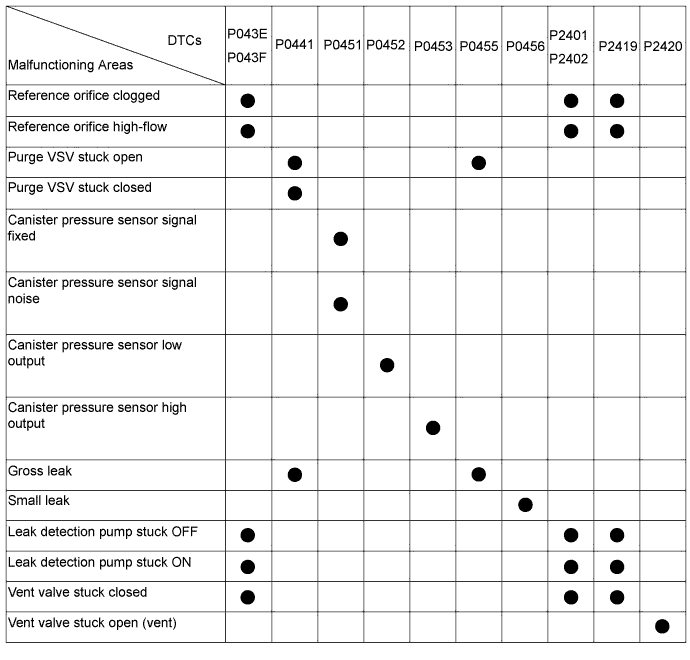
- NOTICE:
- If the reference pressure difference between the first and second checks is greater than the specification, all the DTCs relating to the reference pressure (P043E, P043F, P2401, P2402 and P2419) are stored.
DESCRIPTION
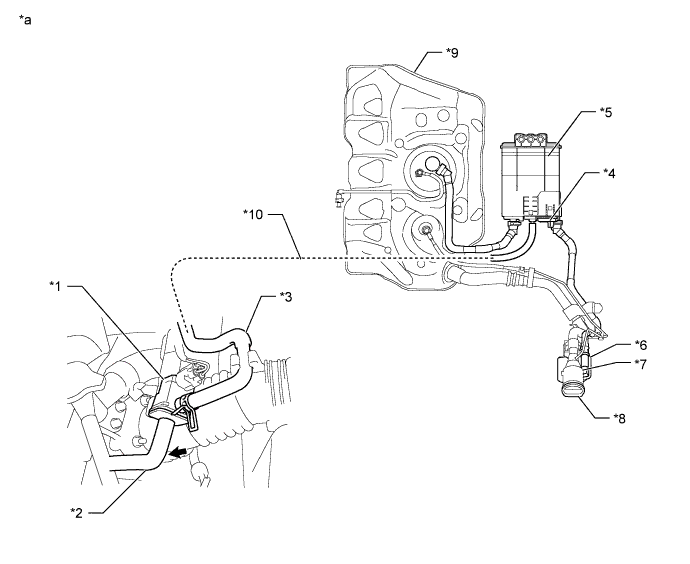
| *1 | Purge VSV | *2 | EVAP Hose (to Intake Manifold) |
| *3 | EVAP Hose (from Canister) | *4 | Canister Pump Module - Canister Pressure Sensor - Leak Detection Pump - Vent Valve |
| *5 | Canister | *6 | Canister Filter |
| *7 | Air Inlet Port (behind Filler Pipe Flange Plate) | *8 | Fuel Cap |
| *9 | Fuel Tank | *10 | Purge Line |
| *a | Location of EVAP (Evaporative Emission) System | - | - |
- HINT:
- The canister pressure sensor, the leak detection pump and the vent valve are built into the canister pump module.
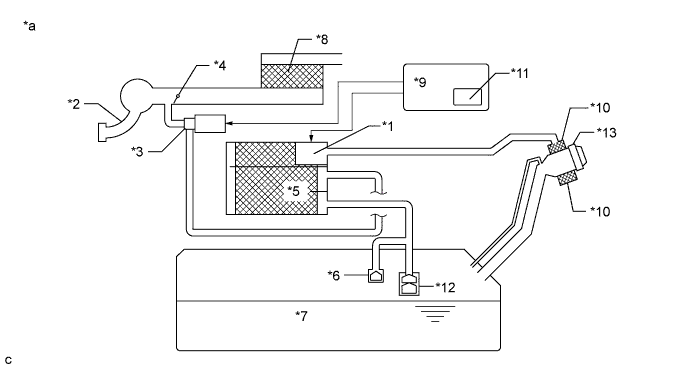
| *1 | Canister Pump Module | *2 | Intake Manifold |
| *3 | Purge VSV | *4 | Throttle Valve |
| *5 | Canister | *6 | Cut-off Valve |
| *7 | Fuel Tank | *8 | Air Cleaner |
| *9 | ECM | *10 | Canister Filter |
| *11 | Soak Timer | *12 | Roll-Over Valve |
| *13 | Fuel Cap | - | - |
| *a | EVAP System Circuit | - | - |
- NOTICE:
- In the EVAP system of this vehicle, turning ON the vent valve does not seal off the EVAP system. To check for leaks in the EVAP system, disconnect the air inlet vent hose and apply pressure from atmospheric side of the canister.
The purge flow volume is also determined by the intake manifold pressure. Atmospheric pressure is allowed into the canister through the vent valve to ensure that the purge flow is maintained when negative pressure (vacuum) is applied to the canister.
The following two monitors run to confirm appropriate EVAP system operation.
| Key-off monitor |
The leak detection pump creates negative pressure (vacuum) in the EVAP system and the pressure is measured. Finally, the ECM monitors for leaks from the EVAP system, and malfunctions in both the canister pump module and purge VSV based on the EVAP pressure.
- HINT:
- *: If the engine coolant temperature is not below 35°C (95°F) 5 hours after the ignition switch is turned off, the monitor check starts 2 hours later. If it is still not below 35°C (95°F) 7 hours after the ignition switch is turned off, the monitor check starts 2.5 hours later.
| Purge flow monitor |
- The 1st monitor
While the engine is running and the purge VSV (Vacuum Switching Valve) is on (open), the ECM monitors the purge flow by measuring the EVAP pressure change. If negative pressure is not created, the ECM begins the 2nd monitor. - The 2nd monitor
The vent valve is turned ON (closed) and the EVAP pressure is then measured. If the variation in the pressure is less than 0.15 kPa(gauge) [1.13 mmHg(gauge)], the ECM interprets this as the purge VSV being stuck closed, and illuminates the MIL and stores DTC P0441 (2 trip detection logic).
- Atmospheric pressure check:
- In order to ensure reliable malfunction detection, the variation between the atmospheric pressures, before and after of the purge flow monitor, is measured by the ECM.
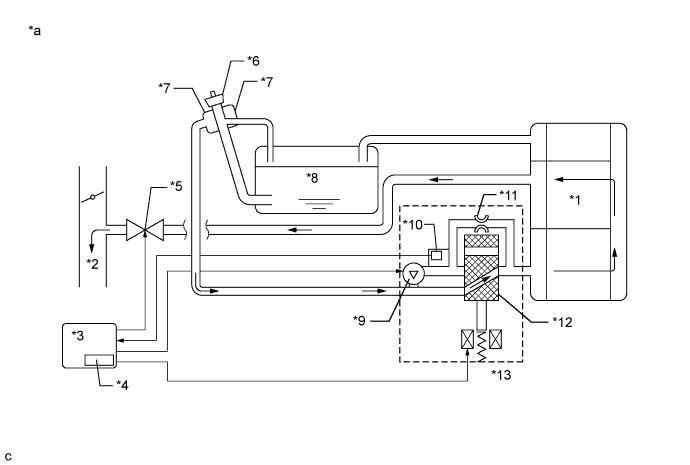
| *1 | Canister | *2 | to Intake Manifold |
| *3 | ECM | *4 | Soak Timer |
| *5 | Purge VSV (On) | *6 | Fuel Cap |
| *7 | Canister Filter | *8 | Fuel Tank |
| *9 | Leak Detection Pump (Off) | *10 | Canister Pressure Sensor |
| *11 | Reference Orifice (0.02 inches) | *12 | Vent Valve (Off) |
| *13 | Canister Pump Module | - | - |
| *a | EVAP Purge Flow | - | - |
| Component | Operation |
| Canister | Contains activated charcoal to absorb EVAP (Evaporative Emissions) generated in fuel tank. |
| Cut-off valve | Located in fuel tank. Valve floats and closes when fuel tank is 100% full. |
| Purge VSV (Vacuum Switching Valve) | Opens or closes line between canister and intake manifold. ECM uses purge VSV to control EVAP purge flow. In order to discharge EVAP absorbed by canister to intake manifold, ECM opens purge VSV. EVAP discharge volume to intake manifold controlled by purge VSV duty cycle (current-carrying time). (Open: on, Close: off) |
| Roll-over valve | Located in fuel tank. Valve closes by its own weight when vehicle overturns to prevent fuel from spilling out. |
| Soak timer | Built into ECM. To ensure accurate EVAP monitor, measures 5 hours (+/-15 min) after ignition switch is turned off. This allows fuel to cool down, stabilizing EVAP pressure. When approximately 5 hours elapsed, ECM activates (refer to fig. 3). |
| Canister pump module | Consists of (a) to (d) below. Canister pump module cannot be disassembled. |
| (a) Vent valve | Vents and closes EVAP system. When ECM turns valve on, EVAP system is closed. When ECM turns valve off, EVAP system is vented. Negative pressure (vacuum) is created in EVAP system to check for EVAP leaks by closing purge VSV, turning on vent valve (closing it) and operating leak detection pump (refer to fig. 1). |
| (b) Canister pressure sensor | Indicates pressure as voltages. ECM supplies regulated 5 V to pressure sensor, and uses feedback from sensor to monitor EVAP system pressure (refer to fig. 2). |
| (c) Leak detection pump | Creates negative pressure (vacuum) in EVAP system for leak check. |
| (d) Reference orifice | Has opening with 0.02 inch diameter. Vacuum is produced through orifice by closing purge VSV, turning off vent valve and operating leak detection pump, to monitor reference pressure. Reference pressure indicates a small leak of EVAP. |
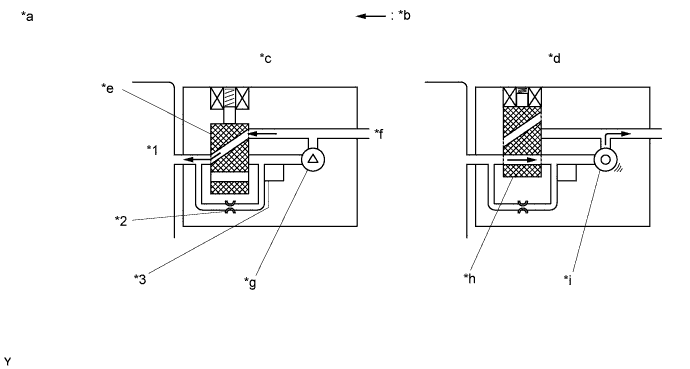
| *1 | Canister | *2 | Reference Orifice (0.02 Inch) |
| *3 | Canister Pressure Sensor | - | - |
| *a | Canister Pump Module (fig. 1) | *b | Airflow |
| *c | Condition: Purge Flow | *d | Condition: Leak Check |
| *e | Vent Valve: off (vent) | *f | to Canister Filter (Atmosphere) |
| *g | Leak Detection Pump: off | *h | Vent Valve: on (closed) |
| *i | Leak Detection Pump: on | - | - |

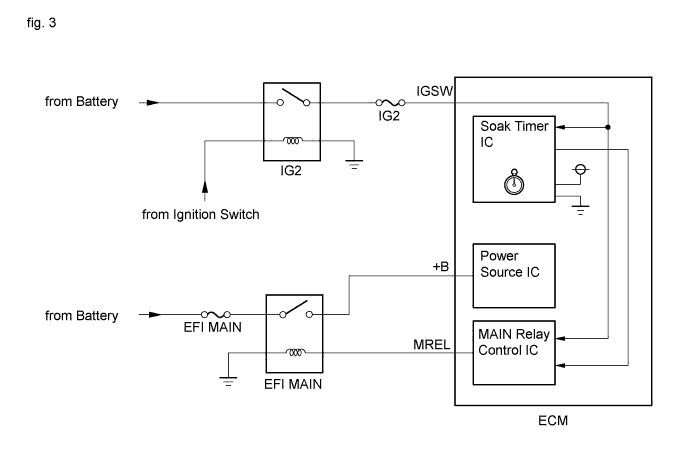
WIRING DIAGRAM
Refer to DTC P0451 (Click here).INSPECTION PROCEDURE
- NOTICE:
- Inspect the fuses for circuits related to this system before performing the following inspection procedure.
- The Techstream is required to conduct the following diagnostic troubleshooting procedure.
- HINT:
- Using the Techstream monitor results enables the EVAP (Evaporative Emission) system to be confirmed.
- Read freeze frame data using the Techstream. The ECM records vehicle and driving condition information as freeze frame data the moment a DTC is stored. When troubleshooting, freeze frame data can help determine if the vehicle was moving or stationary, if the engine was warmed up or not, if the air fuel ratio was lean or rich, and other data from the time the malfunction occurred.
| 1.CONFIRM DTC |
Turn the ignition switch off and wait for 10 seconds.
Turn the ignition switch to ON.
Turn the ignition switch off and wait for 10 seconds.
Connect the Techstream to the DLC3.
Turn the ignition switch to ON and turn the Techstream on.
Enter the following menus: Powertrain / Engine and ECT / Trouble Codes.
Confirm DTCs and freeze frame data.
If any EVAP system DTCs are stored, the malfunctioning area can be determined using the table below.
- NOTICE:
- If the reference pressure difference between the first and second checks is greater than the specification, all the DTCs relating to the reference pressure (P043E, P043F, P2401, P2402 and P2419) are stored.
| NEXT | |
| 2.PERFORM EVAP SYSTEM CHECK (AUTOMATIC MODE) |
- NOTICE:
- The Evaporative System Check (Automatic Mode) consists of 6 steps performed automatically by the Techstream. It takes a maximum of approximately 24 minutes.
- Do not perform the Evaporative System Check when the fuel tank is more than 90% full because the cut-off valve may be closed, making the fuel tank leak check unavailable.
- Do not run the engine during this operation.
- When the temperature of the fuel is 35°C (95°F) or more, a large amount of vapor forms and any check results become inaccurate. When performing the Evaporative System Check, keep the temperature below 35°C (95°F).
Connect the Techstream to the DLC3.
Turn the ignition switch to ON.
Turn the Techstream on.
Clear the DTCs (Click here).
Enter the following menus: Powertrain / Engine and ECT / Utility / Evaporative System Check / Automatic Mode.
After the Evaporative System Check is completed, check for pending DTCs by entering the following menus: Powertrain / Engine and ECT / Trouble Codes.
- HINT:
- If no pending DTCs are displayed, perform the Confirmation Driving Pattern. After this confirmation, check for pending DTCs. If no DTCs are displayed, the EVAP system is normal.
| NEXT | |
| 3.PERFORM EVAP SYSTEM CHECK (MANUAL MODE) |
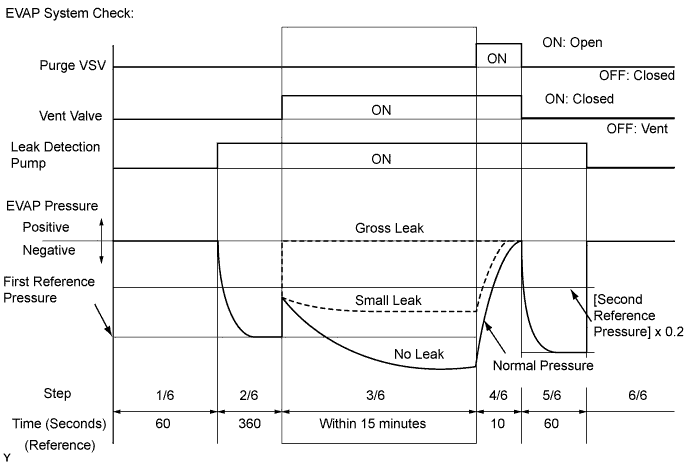
- NOTICE:
- In the Evaporative System Check (Manual Mode), the series of 6 Evaporative System Check steps are performed manually using the Techstream.
- Do not perform the Evaporative System Check when the fuel tank is more than 90% full because the cut-off valve may be closed, making the fuel tank leak check unavailable.
- Do not run the engine during this operation.
- When the temperature of the fuel is 35°C (95°F) or more, a large amount of vapor forms and any check results become inaccurate. When performing the Evaporative System Check, keep the temperature below 35°C (95°F).
Connect the Techstream to the DLC3.
Turn the ignition switch to ON.
Turn the Techstream on.
Clear the DTCs (Click here).
Enter the following menus: Powertrain / Engine and ECT / Utility / Evaporative System Check / Manual Mode.
| NEXT | |
| 4.PERFORM EVAP SYSTEM CHECK (STEP 1/6) |

Check the EVAP pressure in step 1/6.
Result DTC
*1Result Suspected Trouble Area Proceed to - Virtually no variation in EVAP pressure Not yet determined A P0451 EVAP pressure fluctuates by +/-0.3 kPa(gauge) [2.25 mmHg(gauge)] or more Canister pressure sensor signal noise B (P0452 or P0453)
*2- EVAP pressure is below 42.11009 kPa(abs) [315.85178 mmHg(abs)] or 123.76147 kPa(abs) [928.28776 mmHg(abs)] or more
- EVAP pressure deviates +/-10 kPa [+/-75 mmHg] from actual atmosphere pressure *3
Canister pressure sensor or its circuit has malfunction C - *1: These DTCs are already present in the ECM when the vehicle arrives and are confirmed in the "Confirm DTC" procedure above.
- *2: If the canister pressure sensor circuit has an open or short, DTC P0452 or P0453 is stored 0.5 seconds after the ignition switch is turned to ON.
- HINT:
- *3: Canister pressure sensor standard output range is 70 to 110 kPa(abs) [525 to 825 mmHg(abs)]. This varies by weather.
- EVAP pressure is below 42.11009 kPa(abs) [315.85178 mmHg(abs)] or 123.76147 kPa(abs) [928.28776 mmHg(abs)] or more
|
| ||||
|
| ||||
| A | |
| 5.PERFORM EVAP SYSTEM CHECK (STEP 1/6 TO 2/6) |
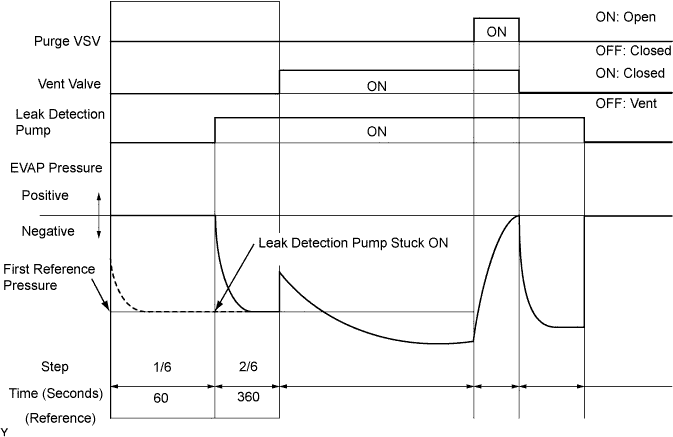
Check the EVAP pressure in steps 1/6 and 2/6.
*: These DTCs are already present in the ECM when the vehicle arrives and are confirmed in the "Confirm DTC" procedure above.Result DTC* Result Suspected Trouble Area Proceed to - Virtually no variation in EVAP pressure during step 1/6. Then decreases to reference pressure Not yet determined A P2402 Small difference between EVAP pressures during steps 1/6 and 2/6 Leak detection pump stuck ON B - HINT:
- The first reference pressure is the value determined in step 2/6.
|
| ||||
| A | |
| 6.PERFORM EVAP SYSTEM CHECK (STEP 2/6) |
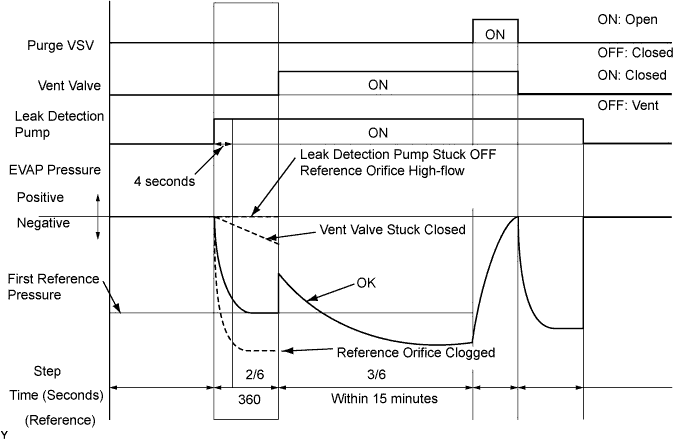
- HINT:
- Make a note of the pressures checked in inspection items (A) and (B) below.
Check the EVAP pressure 4 seconds after the leak detection pump is activated*1 (A).
*1: The leak detection pump begins to operate as step 1/6 finishes and step 2/6 starts.
Check the EVAP pressure again when it has stabilized. This pressure is the reference pressure (B).
*2: These DTCs are already present in the ECM when the vehicle arrives and are confirmed in the "Confirm DTC" procedure above.Result DTC*2 Result Suspected Trouble Area Proceed to - EVAP pressure in inspection item (B) is between -4.85 kPa(gauge) and -1.057 kPa(gauge) [-36.377 mmHg(gauge) and -7.928 mmHg(gauge)] Not yet determined A P043F and P2401 EVAP pressure in inspection item (B) is -1.057 kPa(gauge) [-7.928 mmHg(gauge)] or more - Reference orifice high-flow
- Leak detection pump stuck OFF
B P043E EVAP pressure in inspection item (B) is less than -4.85 kPa(gauge) [-36.377 mmHg(gauge)] Reference orifice clogged C P2419 EVAP pressure in inspection item (A) is more than -0.25 kPa(gauge) [-1.875 mmHg(gauge)] - Vent valve stuck closed
- Leak detection pump performance deteriorates
- Leak detection pump circuit malfunctioning (large resistance exists in the circuit)
D - Reference orifice high-flow
|
| ||||
|
| ||||
|
| ||||
| A | |
| 7.PERFORM EVAP SYSTEM CHECK (STEP 2/6 TO 3/6) |

Check the EVAP pressure in step 3/6.
*: These DTCs are already present in the ECM when the vehicle arrives and are confirmed in the "Confirm DTC" procedure above.Result DTC* Result Suspected Trouble Area Proceed to - EVAP pressure increases by 0.3 kPa(gauge) [2.25 mmHg(gauge)] or more within 10 seconds of proceeding from step 2/6 to step 3/6 Not yet determined A P2420 No variation in EVAP pressure even after proceeding from step 2/6 to step 3/6 - Vent valve stuck open (vent)
- Canister (charcoal filter inside canister) clogged
B P0451 No variation in EVAP pressure during steps 1/6 through 3/6 - Canister pressure sensor output value stuck
- Vent valve broken (valve split in two)
- Leak detection pump performance deteriorates
- Leak detection pump circuit malfunctioning (large resistance exists in the circuit)
C - Vent valve stuck open (vent)
|
| ||||
|
| ||||
| A | |
| 8.PERFORM EVAP SYSTEM CHECK (STEP 3/6) |
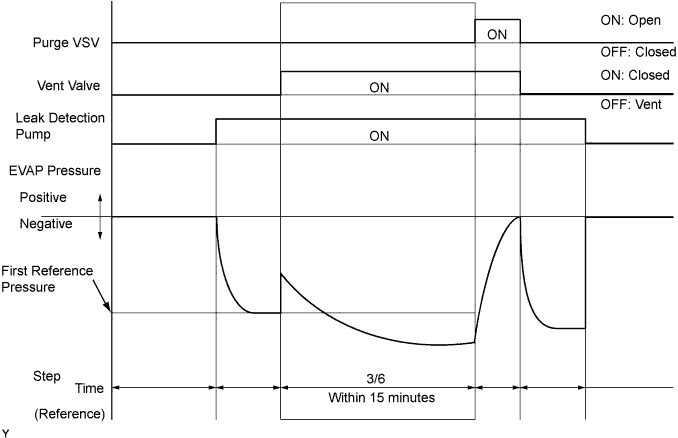
Wait until the EVAP pressure change is less than 0.12 kPa(gauge) [0.9 mmHg(gauge)] for 40 seconds.
Measure the EVAP pressure and record it.
- HINT:
- A few minutes are required for the EVAP pressure to become saturated. When there is little fuel in the fuel tank, it takes up to 15 minutes.
| NEXT | |
| 9.PERFORM EVAP SYSTEM CHECK (STEP 4/6) |

Check the EVAP pressure in step 4/6.
Result DTC*1 Result Suspected Trouble Area Proceed to - EVAP pressure increases by 0.3 kPa(gauge) [2.25 mmHg(gauge)] or more within 10 seconds of proceeding from step 3/6 to step 4/6 Not yet determined A P0441
*2EVAP pressure increases by 0.3 kPa(gauge) [2.25 mmHg(gauge)] or more within 10 seconds of proceeding from step 3/6 to step 4/6 - Purge VSV
- Purge VSV circuit
- Problems in EVAP hose between purge VSV and intake manifold
- Problems in EVAP hose between canister and purge VSV
- ECM
B P0441 Variation in EVAP pressure is less than 0.3 kPa(gauge) [2.25 mmHg(gauge)] for 10 seconds, after proceeding from step 3/6 to step 4/6 - Purge VSV stuck closed
- Purge VSV circuit
- Canister (charcoal filter inside canister) clogged
- Problems in EVAP hose between purge VSV and intake manifold
- Problems in EVAP hose between canister and purge VSV
- ECM
C - *1: These DTCs are already present in the ECM when the vehicle arrives and are confirmed in the "Confirm DTC" procedure above.
- *2: This result suggests that due to purge line blockage or purge VSV malfunction, the DTC was stored by the purge flow monitor while the engine was running, or that key-off monitor test result were nearly borderline values.
- Purge VSV
|
| ||||
|
| ||||
| A | |
| 10.PERFORM EVAP SYSTEM CHECK (STEP 5/6) |

Check the EVAP pressure in step 5/6.
Compare the EVAP pressure in step 3/6 and the second reference pressure (step 5/6).
*: These DTCs are already present in the ECM when the vehicle arrives and are confirmed in the "Confirm DTC" procedure above.Result DTC* Result Suspected Trouble Area Proceed to - EVAP pressure from step 3/6 lower than second reference pressure (step 5/6) Not yet determined (no leakage from EVAP system) A P0441 and P0455 EVAP pressure from step 3/6 higher than [second reference pressure (step 5/6) x 0.2] - Purge VSV stuck open
- EVAP gross leak
B P0456 EVAP pressure from step 3/6 higher than second reference pressure (step 5/6) EVAP small leak B - Purge VSV stuck open
|
| ||||
|
| ||||
| 11.PERFORM EVAP SYSTEM CHECK (STEP 3/6) |
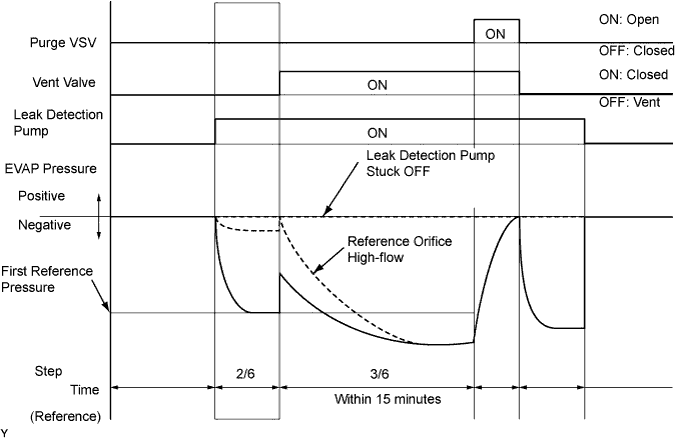
Check the EVAP pressure in step 3/6.
*: These DTCs are already present in the ECM when the vehicle arrives and are confirmed in the "Confirm DTC" procedure above.Result DTC* Result Suspected Trouble Area Proceed to P043F EVAP pressure less than [reference pressure] measured in step 2/6 Reference orifice high-flow A P2401 EVAP pressure almost same as [reference pressure] measured in step 2/6 Leak detection pump stuck off B - HINT:
- The first reference pressure is the value determined in step 2/6.
|
| ||||
|
| ||||
| 12.INSPECT CANISTER PUMP MODULE (CANISTER PRESSURE SENSOR CIRCUIT) |
Check the canister pressure sensor circuit, referring to DTC P0451 canister pressure sensor circuit inspection procedure (Click here).
|
| ||||
| 13.INSPECT CANISTER PUMP MODULE (VENT VALVE OPERATION) |
Turn the ignition switch off.
Disconnect the J70 canister pump module connector.
Text in Illustration *a Component without harness connected
(Canister Pump Module)
 |
Apply the battery voltage to terminals VLVB and VGND of the pump module.
Touch the canister pump module to confirm the vent valve operation.
Result Condition Tester Result Suspected Trouble Area Proceed to Apply battery voltage to terminals VLVB and VGND Operating - Wire harness or connector between vent valve and ECM
- Leak detection pump performance deteriorates
- Leak detection pump circuit malfunctioning (large resistance exists in the circuit)
- ECM
A Not operating Vent valve B - Wire harness or connector between vent valve and ECM
|
| ||||
| A | |
| 14.CHECK HARNESS AND CONNECTOR (CANISTER PUMP MODULE - ECM) |
Turn the ignition switch off.
Disconnect the J70 canister pump module connector.
Disconnect the A72 ECM connector.
Measure the resistance according to the value(s) in the table below.
- Standard Resistance:
Tester Connection Condition Specified Condition A72-5 (VPMP) - J70-1 (VGND) Always Below 1 Ω A72-5 (VPMP) or J70-1 (VGND) - Body ground Always 10 kΩ or higher
Result Result Suspected Trouble Area Proceed to OK - Leak detection pump performance deteriorates
- Leak detection pump circuit malfunctioning (large resistance exists in the circuit)
- ECM
A NG Wire harness or connector between ECM and canister pump module B
|
| ||||
| A | |
| 15.CHECK HARNESS AND CONNECTOR (CANISTER PUMP MODULE - BODY GROUND) |
Disconnect the J70 canister pump module connector.
Measure the resistance according to the value(s) in the table below.
| Tester Connection | Condition | Specified Condition | Suspected Trouble Area | Proceed to |
| J70-4 (MGND) - Body ground | Always | Below 1 Ω |
| A |
| 10 kΩ or higher | Wire harness or connector between canister pump module and body ground | B |
|
| ||||
| A | |
| 16.CHECK HARNESS AND CONNECTOR (ECM - CANISTER PUMP MODULE) |
Disconnect the J70 canister pump module connector.
Disconnect the A72 ECM connector.
Measure the resistance according to the value(s) in the table below.
| Tester Connection | Condition | Specified Condition | Suspected Trouble Area | Proceed to |
| A72-18 (MPMP) - J70-3 (MTRB) | Always | Below 1 Ω |
| A |
| 10 kΩ or higher | Wire harness or connector between ECM and canister pump module | B |
|
| ||||
|
| ||||
| 17.PERFORM ACTIVE TEST USING TECHSTREAM (PURGE VSV) |
Enter the following menus: Powertrain / Engine and ECT / Active Test / Activate the VSV for EVAP Control.
Disconnect the hose (connected to the canister) from the purge VSV.
Text in Illustration *1 Purge VSV *2 Hose (to Canister)
 |
Start the engine.
Using the Techstream, turn off the purge VSV (Activate the VSV for Evap Control: OFF).
Use your finger to confirm that the purge VSV has no suction.
Using the Techstream, turn on the purge VSV (Activate the VSV for Evap Control: ON).
Use your finger to confirm that the purge VSV has suction.
Result Test Result Suspected Trouble Area Proceed to No suction when purge VSV turned off, and suction applied when turned on Blockage in the purge line is considered (based on result of step 9): - Problems with EVAP hose between canister and purge VSV
- Canister (charcoal filter inside canister) clogged
- ECM
A Leakage is considered (based on result of step 10): - Fuel cap
- Leakage from EVAP line, fuel tank, or canister
B Suction applied when purge VSV turned off - Purge VSV stuck open
C No suction when purge VSV turned on - Purge VSV stuck closed
- Problems with EVAP hose between purge VSV and intake manifold
D - Problems with EVAP hose between canister and purge VSV
|
| ||||
|
| ||||
|
| ||||
| A | |
| 18.INSPECT EVAP HOSE (PURGE VSV - CANISTER) |
Check for blockages in the EVAP purge line between the purge VSV and canister.
- OK:
- No blockages in the EVAP purge line between the purge VSV and canister.
|
| ||||
| OK | |
| 19.INSPECT CANISTER (CHARCOAL FILTER INSIDE CANISTER) |
Check for filter blockage in the canister (Click here).
- OK:
- No blockages in the canister.
|
| ||||
|
| ||||
| 20.CHECK FUEL CAP ASSEMBLY |
Check that the fuel cap is correctly installed and confirm that the fuel cap meets OEM specifications.
Tighten the fuel cap firmly (only one click sound could be heard).
- HINT:
- If an EVAP tester is available, check the fuel cap using the tester.
Remove the fuel cap and install it onto a fuel cap adapter.
Connect an EVAP tester pump hose to the adapter, and pressurize the cap to 3.2 to 3.7 kPa(gauge) [24 to 28 mmHg(gauge)] using an EVAP tester pump.
Seal the adapter and wait for 2 minutes.
Check the pressure. If the pressure is 2 kPa(gauge) [15 mmHg(gauge)] or more, the fuel cap is normal.
Result Test Result Suspected Trouble Area Proceed to Fuel cap correctly installed - A Fuel cap loose - Fuel cap improperly installed
- Defective fuel cap
- Fuel cap does not meet OEM specifications
B Defective fuel cap - B No fuel cap - C - Fuel cap improperly installed
|
| ||||
|
| ||||
|
| ||||
| 21.INSPECT PURGE VSV |
Turn the ignition switch off.
Disconnect the C59 purge VSV connector.
Text in Illustration *1 Hose (to Canister) *2 Connector *3 Purge VSV
 |
Disconnect the hose (connected to the canister) from the purge VSV.
Start the engine.
Use your finger to confirm that the purge VSV has no suction.
Result Test Result Suspected Trouble Area Proceed to No suction - Wire harness or connector between purge VSV and ECM (short to ground)
- ECM
A Suction applied Purge VSV B - Wire harness or connector between purge VSV and ECM (short to ground)
|
| ||||
|
| ||||
| 22.INSPECT EVAP HOSE (PURGE VSV - CANISTER) |
Check for blockages in the EVAP purge line between the purge VSV and canister.
- OK:
- No blockages in the EVAP purge line between the purge VSV and canister.
|
| ||||
| OK | |
| 23.CHECK EVAP HOSE (PURGE VSV - INTAKE MANIFOLD) |
Disconnect the hose (connected to the intake manifold) from the purge VSV.
Text in Illustration *1 Purge VSV *2 Hose (to intake manifold)
 |
Start the engine.
Use your finger to confirm that the hose has suction.
Result Test Result Suspected Trouble Area Proceed to Suction applied EVAP hose between purge VSV and intake manifold normal - Purge VSV
- Purge VSV power source
- Wire harness or connector between purge VSV and ECM
A No suction - Intake manifold port
- EVAP hose between purge VSV and intake manifold
B - Purge VSV
|
| ||||
| A | |
| 24.INSPECT PURGE VSV |
Remove the purge VSV.
Apply battery voltage to the terminals of the purge VSV.
Text in Illustration *1 Purge VSV
 |
Confirm that air flows from port E to port F.
Result Test Result Condition Suspected Trouble Area Proceed to Air flows Battery voltage is applied to purge VSV terminals Purge VSV normal - Purge VSV power source
- Wire harness or connector between purge VSV and ECM
A No air flow Battery voltage is applied to purge VSV terminals Purge VSV B - Purge VSV power source
|
| ||||
| A | |
| 25.CHECK TERMINAL VOLTAGE (POWER SOURCE OF PURGE VSV) |
Disconnect the purge VSV connector.
Turn the ignition switch to ON.
Text in Illustration *a Front view of wire harness connector
(to Purge VSV)
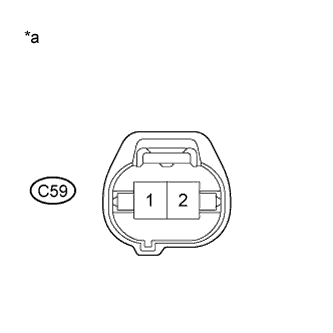 |
Measure the voltage according to the value(s) in the table below.
Result Tester Connection Switch Condition Specified Condition Suspected Trouble Area Proceed to C59-1 - Body ground Ignition switch ON 11 to 14 V Purge VSV power source normal - Wire harness or connector between purge VSV and ECM
A Other than result above Wire harness or connectors between purge VSV and battery B - Wire harness or connector between purge VSV and ECM
|
| ||||
| A | |
| 26.CHECK HARNESS AND CONNECTOR (PURGE VSV - ECM) |
Disconnect the C51 ECM connector.
Disconnect the purge C59 VSV connector.
Measure the resistance according to the value(s) in the table below.
- Standard Resistance:
Tester Connection Condition Specified Condition C59-2 - C51-76 (PRG) Always Below 1 Ω C59-2 or C51-76 (PRG) - Body ground Always 10 kΩ or higher
|
| ||||
|
| ||||
| 27.INSPECT CANISTER PUMP MODULE (POWER SOURCE FOR VENT VALVE) |
Turn the ignition switch off.
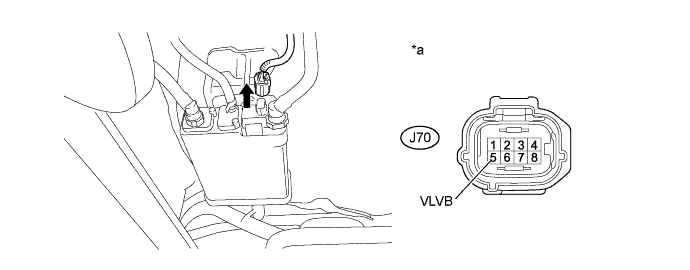
| *a | Front view of wire harness connector (to Canister Pump Module) | - | - |
Disconnect the canister pump module connector.
Turn the ignition switch to ON.
Measure the voltage according to the value(s) in the table below.
Result Tester Connection Switch Condition Specified Condition Suspected Trouble Area Proceed to J70-5 (VLVB) - Body ground Ignition switch ON 11 to 14 V - Wire harness or connector between vent valve and ECM
- Vent valve
- Canister (charcoal filter inside canister) clogged
- ECM
A Below 3 V - Power source wire harness of vent valve
B - Wire harness or connector between vent valve and ECM
|
| ||||
| A | |
| 28.INSPECT CANISTER PUMP MODULE (VENT VALVE OPERATION) |
Turn the ignition switch off.
Disconnect the J70 canister pump module connector.
Text in Illustration *a Component without harness connected
(Canister Pump Module)
 |
Apply the battery voltage to terminals VLVB and VGND of the pump module.
Touch the canister pump module to confirm the vent valve operation.
Result Condition Tester Result Suspected Trouble Area Proceed to Apply battery voltage to terminals VLVB and VGND Operating - Wire harness or connector between vent valve and ECM
- Canister (charcoal filter inside canister) clogged
- ECM
A Not operating - Vent valve
B - Wire harness or connector between vent valve and ECM
|
| ||||
| A | |
| 29.CHECK HARNESS AND CONNECTOR (CANISTER PUMP MODULE - ECM) |
Turn the ignition switch off.
Disconnect the J70 canister pump module connector.
Disconnect the A72 ECM connector.
Measure the resistance according to the value(s) in the table below.
Result Tester Connection Condition Test Result Suspected Trouble Area Proceed to A72-5 (VPMP) - J70-1 (VGND) Always Below 1 Ω - Canister (charcoal filter inside canister) clogged
- ECM
A 10 kΩ or higher Wire harness or connector between ECM and canister pump module B - Canister (charcoal filter inside canister) clogged
|
| ||||
| A | |
| 30.INSPECT CANISTER (CHARCOAL FILTER INSIDE CANISTER) |
Check for filter blockage in the canister (Click here).
- OK:
- No blockages in the canister.
|
| ||||
|
| ||||
| 31.CHECK TERMINAL VOLTAGE (CANISTER PUMP MODULE) |
Turn the ignition switch off.
Disconnect the canister pump module connector.
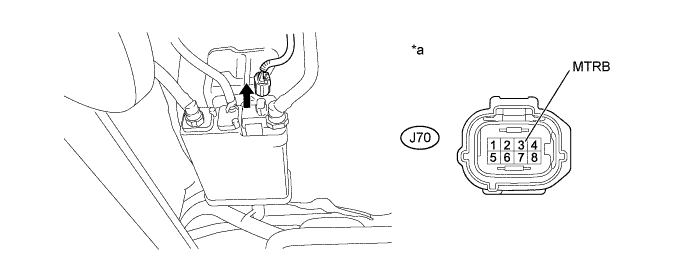
Text in Illustration *a Front view of wire harness connector
(to Canister Pump Module)- -
Turn the ignition switch to ON.
Measure the voltage according to the value(s) in the table below.
Result Tester Connection Condition Test Result Suspected Trouble Area Proceed to J70-3 (MTRB) - Body ground Ignition switch ON 9 to 14 V - Wire harness or connector between leak detection pump and body ground
- Leak detection pump
A Below 3 V - Wire harness or connector between leak detection pump and ECM
- ECM
B - Wire harness or connector between leak detection pump and body ground
|
| ||||
| A | |
| 32.CHECK HARNESS AND CONNECTOR (CANISTER PUMP MODULE - BODY GROUND) |
Turn the ignition switch off.
Disconnect the J70 canister pump module connector.
Measure the resistance according to the value(s) in the table below.
| Tester Connection | Condition | Specified Condition | Suspected Trouble Area | Proceed to |
| J70-4 (MGND) - Body ground | Always | Below 1 Ω | Leak detection pump | A |
| 10 kΩ or higher | Wire harness or connector between canister pump module and body ground | B |
|
| ||||
|
| ||||
| 33.CHECK HARNESS AND CONNECTOR (ECM - CANISTER PUMP MODULE) |
Turn the ignition switch off.
Disconnect the J70 canister pump module connector.
Disconnect the A72 ECM connector.
Measure the resistance according to the value(s) in the table below.
- Standard Resistance:
Tester Connection Condition Specified Condition A72-18 (MPMP) - J70-3 (MTRB) Always Below 1 Ω A72-18 (MPMP) or J70-3 (MTRB) - Body ground Always 10 kΩ or higher
| Result | Suspected Trouble Area | Proceed to |
| OK | ECM | A |
| NG | Wire harness or connector between ECM and canister pump module | B |
|
| ||||
|
| ||||
| 34.INSPECT INTAKE MANIFOLD (EVAP PURGE PORT) |
Stop the engine.
Disconnect the EVAP hose (connected to the purge VSV) from the intake manifold.
Start the engine.
Use your finger to confirm that the port of the intake manifold has suction.
| Tester Connection | Suspected Trouble Area | Proceed to |
| Suction applied | EVAP hose between intake manifold and purge VSV | A |
| No suction | Intake manifold | B |
|
| ||||
|
| ||||
| 35.CORRECTLY REINSTALL OR REPLACE FUEL TANK CAP ASSEMBLY |
- HINT:
- When reinstalling the fuel cap, tighten it firmly (only one click sound could be heard).
- When replacing the fuel cap, use a fuel cap that meets OEM specifications, and install it firmly.
|
| ||||
| 36.REPLACE FUEL TANK CAP ASSEMBLY |
- HINT:
- When installing the fuel cap, tighten it firmly (only one click sound could be heard).
|
| ||||
| 37.LOCATE EVAP LEAK PART |
Disconnect the vent hose.
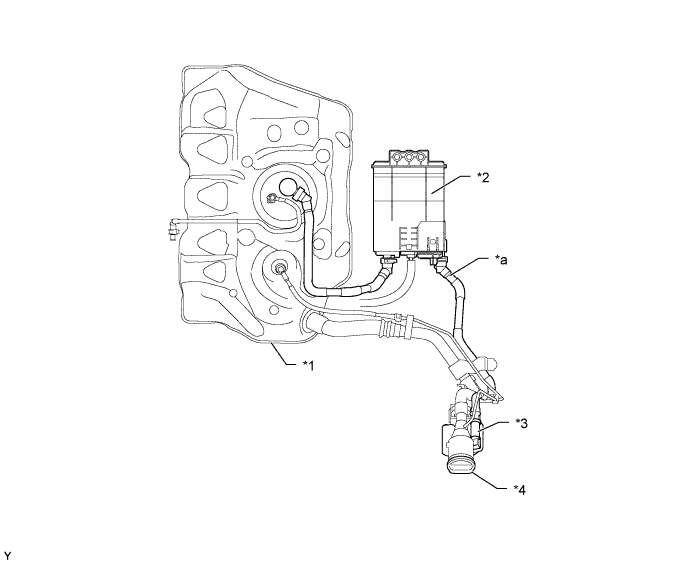
Text in Illustration *1 Fuel Tank *2 Canister *3 Canister Filter *4 Fuel Cap *a Disconnect the vent here - -
Connect the EVAP pressure tester tool to the canister pump module with the adapter.

Text in Illustration *1 Canister Pump Module *2 Adapter *3 EVAP Pressure Tester Tool - -
Pressurize the EVAP system to 3.2 to 3.7 kPa(gauge) [24 to 28 mmHg(gauge)].
Apply soapy water to the piping and connecting parts of the EVAP system.
Look for areas where bubbles appear. This indicates the leak point.
Repair or replace the leak point.
- HINT:
- Disconnect the hose between the canister and fuel tank from the canister. Block the canister side and conduct an inspection. In this way, the fuel tank can be excluded as an area suspected of causing fuel leaks.
|
| ||||
| 38.REPLACE CANISTER |
Replace the canister (Click here).
- NOTICE:
- When replacing the canister, check the canister pump module interior and related pipes for water, fuel and other liquids. If liquids are present, check for disconnections and/or cracks in the following: 1) the pipe from the air inlet port to the canister pump module; 2) the canister filter; and 3) the fuel tank vent hose.
- Check for filter blockage in the canister filter. if the canister filter has blockages, replace the canister filter.
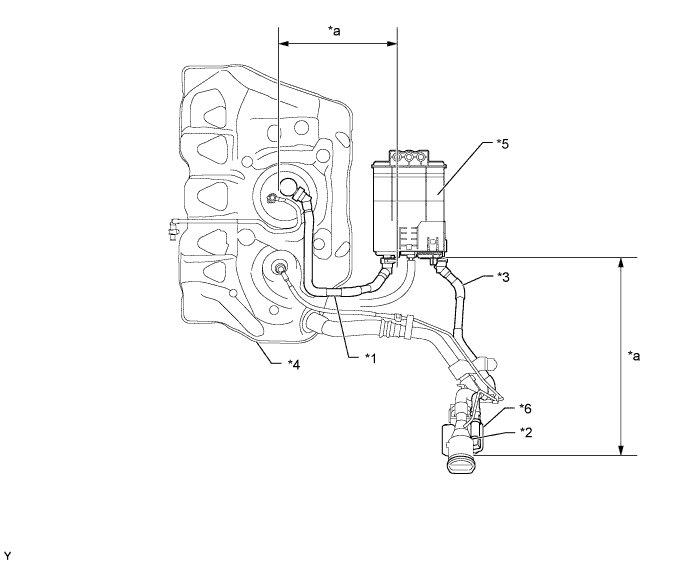
Text in Illustration *1 Fuel Tank Vent Hose *2 Air Inlet Port (behind Filler Pipe Flange Plate) *3 Vent Hose *4 Fuel Tank *5 Canister *6 Canister Filter *a Inspection Area
(check for disconnection and/or cracks)- -
|
| ||||
| 39.REPLACE PURGE VSV |
Replace the purge VSV (Click here).
|
| ||||
| 40.REPAIR OR REPLACE HARNESS OR CONNECTOR |
|
| ||||
| 41.REPAIR OR REPLACE EVAP PURGE LINE (INTAKE MANIFOLD - PURGE VSV) |
|
| ||||
| 42.INSPECT INTAKE MANIFOLD (EVAP PURGE PORT) |
Check that the EVAP purge port of the intake manifold is not clogged. If necessary, replace the intake manifold (Click here).
|
| ||||
| 43.REPAIR OR REPLACE PARTS AND COMPONENTS INDICATED BY OUTPUT DTCS |
Repair the malfunctioning areas indicated by the DTCs that had been confirmed when the vehicle was brought in.
|
| ||||
| 44.REPAIR OR REPLACE EVAP PURGE LINE (PURGE VSV - CANISTER) |
|
| ||||
| 45.REPLACE CANISTER |
Replace the canister (Click here).
- NOTICE:
- When replacing the canister, check the canister pump module interior and related pipes for water, fuel and other liquids. If liquids are present, check for disconnections and/or cracks in the following: 1) the pipe from the air inlet port to the canister pump module; 2) the canister filter; and 3) the fuel tank vent hose.
- Check for filter blockage in the canister filter. if the canister filter has blockages, replace the canister filter.

Text in Illustration *1 Fuel Tank Vent Hose *2 Air Inlet Port (behind Filler Pipe Flange Plate) *3 Vent Hose *4 Fuel Tank *5 Canister *6 Canister Filter *a Inspection Area
(check for disconnection and/or cracks)- -
| NEXT | |
| 46.PERFORM EVAP SYSTEM CHECK (AUTOMATIC MODE) |
- NOTICE:
- The Evaporative System Check (Automatic Mode) consists of 6 steps performed automatically by the Techstream. It takes a maximum of approximately 24 minutes.
- Do not perform the Evaporative System Check when the fuel tank is more than 90% full because the cut-off valve may be closed, making the fuel tank leak check unavailable.
- Do not run the engine in this step.
- When the temperature of the fuel is 35°C (95°F) or more, a large amount of vapor forms and any check results become inaccurate. When performing an Evaporative System Check, keep the fuel temperature below 35°C (95°F).
Connect the Techstream to the DLC3.
Turn the ignition switch to ON.
Turn the Techstream on.
Clear the DTCs (Click here).
Enter the following menus: Powertrain / Engine and ECT / Utility / Evaporative System Check / Automatic Mode.
After the Evaporative System Check is completed, check for pending DTCs by entering the following menus: Powertrain / Engine and ECT / Trouble Codes.
Result Result Proceed to EVAP system DTCs are output A No DTCs output
(No pending DTCs output)B
|
| ||||
| A | |
| 47.REPLACE ECM |
Replace the ECM (Click here).
| NEXT | |
| 48.PERFORM EVAP SYSTEM CHECK (AUTOMATIC MODE) |
- NOTICE:
- The Evaporative System Check (Automatic Mode) consists of 6 steps performed automatically by the Techstream. It takes a maximum of approximately 24 minutes.
- Do not perform the Evaporative System Check when the fuel tank is more than 90% full because the cut-off valve may be closed, making the fuel tank leak check unavailable.
- Do not run the engine in this step.
- When the temperature of the fuel is 35°C (95°F) or more, a large amount of vapor forms and any check results become inaccurate. When performing an Evaporative System Check, keep the fuel temperature below 35°C (95°F).
Connect the Techstream to the DLC3.
Turn the ignition switch to ON.
Turn the Techstream on.
Clear the DTCs (Click here).
Enter the following menus: Powertrain / Engine and ECT / Utility / Evaporative System Check / Automatic Mode.
After the Evaporative System Check is completed, check for pending DTCs by entering the following menus: Powertrain / Engine and ECT / Trouble Codes.
- HINT:
- If no pending DTCs are found, the repair has been successfully completed.
| NEXT | ||
| ||
CONFIRMATION DRIVING PATTERN
- HINT:
- After a repair, check Monitor Status by performing the Key-Off Monitor Confirmation and Purge Flow Monitor Confirmation described below.
| KEY-OFF MONITOR CONFIRMATION |
Preconditions
The monitor will not run unless:- The vehicle has been driven for 10 minutes or more (in a city area or on a freeway).
- The fuel tank is less than 90% full.
- The altitude is less than 7875 ft. (2400 m).
- The engine coolant temperature is between 4.4°C and 35°C (40°F and 95°F).
- The intake air temperature is between 4.4°C and 35°C (40°F and 95°F).
- The vehicle remains stationary (the vehicle speed is 0 km/h [0 mph]).
- The vehicle has been driven for 10 minutes or more (in a city area or on a freeway).
Monitor Conditions
- Allow the engine to idle for at least 5 minutes.
- Turn the ignition switch off and wait for 6 hours (8 or 10.5 hours).
- HINT:
- Do not start the engine until checking Monitor Status. If the engine is started, the steps described above must be repeated.
- Allow the engine to idle for at least 5 minutes.
Monitor Status
- Connect the Techstream to the DLC3.
- Turn the ignition switch to ON.
- Turn the Techstream on.
- Enter the following menus: Powertrain / Engine and ECT / Monitor / Current Monitor.
- Check the Monitor Status displayed on the Techstream.
- HINT:
- If Incomplete is displayed, the monitor did not complete. Make sure that the preconditions have been met, and perform the Monitor Conditions again.
- Connect the Techstream to the DLC3.
| PURGE FLOW MONITOR CONFIRMATION (P0441) |
- HINT:
- Perform this monitor confirmation after the Key-Off Monitor Confirmation shows Complete.
Preconditions
The monitor will not run unless:- The vehicle has been driven for 10 minutes or more (in a city area or on a freeway).
- The engine coolant temperature is 4.4°C (40°F) or higher.
- The intake air temperature is 4.4°C (40°F) or higher.
- The vehicle has been driven for 10 minutes or more (in a city area or on a freeway).
Monitor Conditions
- Release the pressure from the fuel tank by removing and reinstalling the fuel cap.
- Warm the engine up until the engine coolant temperature reaches more than 75°C (167°F).
- Increase the engine speed to 3000 rpm once.
- Allow the engine to idle and turn the A/C switch on for 1 minute.
- Release the pressure from the fuel tank by removing and reinstalling the fuel cap.
Monitor Status
- Turn the ignition switch off (if ON or if the engine is running).
- Connect the Techstream to the DLC3.
- Turn the ignition switch to ON.
- Turn the Techstream on.
- Enter the following menus: Powertrain / Engine and ECT / Monitor / Current Monitor.
- Check the Monitor Status displayed on the Techstream.
- HINT:
- If Incomplete is displayed, the monitor did not complete. Make sure that the preconditions have been met, and perform the Monitor Conditions again.
- Turn the ignition switch off (if ON or if the engine is running).
MONITOR RESULT
Refer to detailed information in Checking Monitor Status (Click here).| Monitor ID | Test ID | Scaling | Unit | Description |
| $3D | $C9 | Multiply by 0.001 | kPa | Test value for small leak |
| Monitor ID | Test ID | Scaling | Unit | Description |
| $3D | $CA | Multiply by 0.001 | kPa | Test value for gross leak |
| Monitor ID | Test ID | Scaling | Unit | Description |
| $3D | $CB | Multiply by 0.001 | kPa | Test value for leak detection pump OFF stuck |
| Monitor ID | Test ID | Scaling | Unit | Description |
| $3D | $CD | Multiply by 0.001 | kPa | Test value for leak detection pump ON stuck |
| Monitor ID | Test ID | Scaling | Unit | Description |
| $3D | $CE | Multiply by 0.001 | kPa | Test value for vent valve OFF stuck |
| Monitor ID | Test ID | Scaling | Unit | Description |
| $3D | $CF | Multiply by 0.001 | kPa | Test value for vent valve ON stuck |
| Monitor ID | Test ID | Scaling | Unit | Description |
| $3D | $D0 | Multiply by 0.001 | kPa | Test value for reference orifice low flow |
| Monitor ID | Test ID | Scaling | Unit | Description |
| $3D | $D1 | Multiply by 0.001 | kPa | Test value for reference orifice high flow |
| Monitor ID | Test ID | Scaling | Unit | Description |
| $3D | $D4 | Multiply by 0.001 | kPa | Test value for purge VSV close stuck |
| Monitor ID | Test ID | Scaling | Unit | Description |
| $3D | $D5 | Multiply by 0.001 | kPa | Test value for purge VSV open stuck |
| Monitor ID | Test ID | Scaling | Unit | Description |
| $3D | $D7 | Multiply by 0.001 | kPa | Test value for purge flow insufficient |
